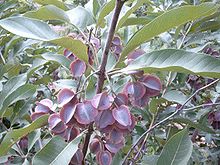Combretum

Combretum, the bushwillows or combretums, make up the type genus of the family Combretaceae. The genus comprises about 272 species of trees and shrubs, most of which are native to tropical and southern Africa, about 5 to Madagascar, but there are others that are native to tropical Asia, New Guinea and the Bismarck Archipelago, Australia, and tropical America. Though somewhat reminiscent of willows (Salix) in their habitus, they are not particularly close relatives of these.
Bushwillow trees often are important plants in their habitat. Savannahs in Africa, in particular those growing on granitic soils, are often dominated by Combretum and its close relative Terminalia. For example, C. apiculatum is a notable tree in the Angolan mopane woodlands ecoregion in the Kunene River basin in southern Africa.[2]
Other species of this genus are a major component of Southwestern Amazonian moist forests. This genus contains several species that are pollinated by mammals other than bats, which is quite rare indeed.[3] But most species are more conventionally pollinated by insects or birds.[citation needed]
Typhlodromus combretum, a mite of the family Phytoseiidae, was discovered on a bushwillow plant and is named after this genus. Other herbivores that eat Combretum foliage include the caterpillars of the Brown Awl (Badamia exclamationis) which is found on C. albidum, C. latifolium and C. ovalifolium; those of the Orange-tailed Awl (Bibasis sena) are recorded from C. extensum and C. latifolium.[citation needed]
